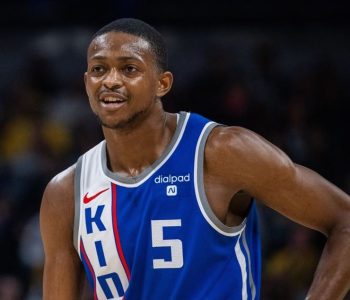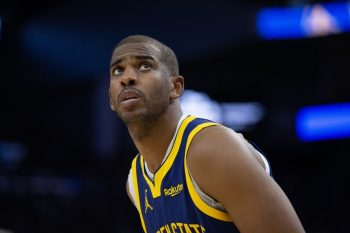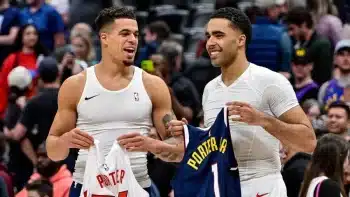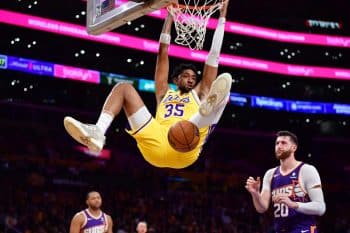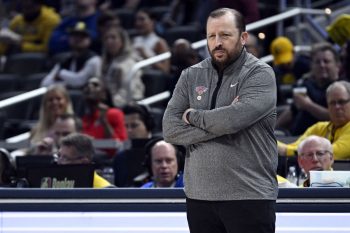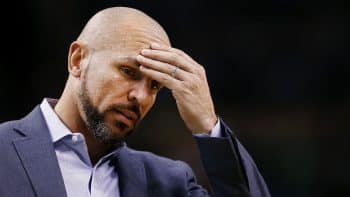NBA
The Divide On Analytics

Once upon a time, during a routine, regular season game, a well-regarded shooter was left alone for a corner three. Iman Shumpert, then with Cleveland, rushed to a hard closeout. Seeing Shumpert off balance, the shooter blew by him.
After the play, LeBron James criticized Shumpert for his overaggression. Shump, understandably, was confused – he’s a shooter! Shooters need to get run off the line!
LeBron responded that from that particular corner, the shooter only shot 35 percent – much worse than his overall three-point percentage that garnered his reputation. Accordingly, LeBron would have rather Shumpert closed under control, baiting the shooter into hoisting from a spot he doesn’t like, rather than letting him drive towards the rim with a full head of steam.
This simple knowledge of percentages has merged into the greater conversation of advanced statistics and analytics. Before these numbers were readily available, a respected jump shooter would never be left alone.
Now, the word “analytics” has transformed from a description into a clustered and contentious field. Even though – especially for those of us without data-processing backgrounds and math degrees – the above illustrates what analytics are and what they provide at their core: Information to make decisions on the micro-level and a tool to inform philosophies on the macro-level.
Dean Oliver and John Hollinger are the founding fathers of the basketball analytics movement. Both statisticians, they eventually parlayed their statistical methods and models into NBA front office jobs. These two paved the way for more recent data savants, such as Seth Partnow and Ben Falk, and their positions with professional basketball teams.
In August, Oliver was hired by the Washington Wizards to be a full-time assistant coach. Falk left the NBA a few years ago and has since started his website, Cleaning the Glass. Partnow and Hollinger both departed from their NBA jobs this year, returning to the media as staff writers for The Athletic.
Selfishly, the advantage of having Falk, Partnow and Hollinger back in the public sphere is the access we have to their brains. Partnow’s latest work is particularly geared towards analytics, and Falk and Hollinger’s are always rooted in them. Reading their work will increase your understanding of how basketball works in its current form and help develop your ideas about where it’s going.
The issue is this: Smart guys talking about numbers seems inaccessible…no matter how accessible it actually is.
Despite the talent of these three – and of all the other mathematicians writing in today’s media – there’s still a misunderstanding between those who wield statistics and those who don’t. Many times, even the players are part of the separation.
On Tuesday, Bulls guard Zach LaVine said this to the Chicago Sun-Times:
“I grew up being a Michael Jordan, Kobe [Bryant] fan… I think the mid-range is a lost art now because everyone is moving towards the threes and the analytics. I understand that because how it looks and how it sounds like it makes sense, but sometimes there’s nothing better than putting the ball in your best playmaker’s hands and letting him get the shot he needs rather than the one you want.”
This led to a revival of the discussion on ESPN’s The Jump. Rachel Nichols seemed to agree with LaVine in part, saying, “two is greater than zero.” Kevin Arnovitz followed with points important for our purpose, calling the death of the mid-range a “false dichotomy.”
“No one is saying, if a guy is wide-open at 19-feet, dribble backwards and take a shot… for Zach LaVine, it’s all about impulse control,” Arnovitz continued.
Impulse control in the sense that deciding when to take a mid-range shot is almost all of the battle. Context matters.
Matt Moore of The Action Network used The Jump’s clip to chime in. Moore tweeted, and then Kevin Durant responded.
The abbreviated version of the Moore-Durant thread is this: Durant, a historically great mid-range jump shooter, argues the side of, well, a historically great jump shooter. He talks about taking open shots regardless of where they come and a player’s confidence and feel.
Moore counters using the math. The refreshing conversation ends when another Twitter user points out that, since the analytics movement, James Harden’s mid-range attempts have dipped drastically. Durant admits he didn’t realize this.
The most telling part of the misunderstandings surrounding analytics came from Durant. He said, “I don’t view the game as math…I get what you’re saying but we just have 2 different views of the game. Analytics is a good way to simplify things.”
And that, folks, is the rub. That is the separation between fans, players and the John Hollingers of the world – the assumption that statisticians use advanced metrics and therefore see basketball as a math problem, while everyone else analyzes by merely watching the game (because of course, watching the games inherently equals reliable analysis).
But analytics isn’t a high-concept way to digitize the game and ignore the “eye test” Twitter fingers love to cite; they’re mathematical truths used to assess basketball success. Often, the air surrounding analytics is that it’s like me, an English major, taking freshman-year Calculus – impossible to understand. Because again, smart people explaining numbers can be daunting, even when they do it perfectly.
Truthfully, analytics are just more precise ways of discerning what happened in a basketball game. As Ben Taylor explains in one of his breakdowns, Chauncey Billups shooting 43 percent is more effective than Ben Wallace shooting 51 percent for a season. Billups is providing threes and making more free throws at a better rate, so even with Wallace’s higher raw field goal percentage, he’d need to be more accurate from two-point range to match Billups’ efficiency.
You don’t need to even study actual numbers to see why these statistical categories make the game easier to understand.
But, and this is another oft-forgotten point, these calculations are useless without context. In 2015-16, a Kawhi Leonard mid-range – when contextualized with qualifiers like time left on the shot clock – was a good shot. He right around 50 percent from 10-16 feet, so the advantage of taking a three over a two would be offset by Leonard’s 50 percent accuracy. During the same season, Kobe Bryant shot 41 percent from 10-16 feet. A Kobe baseline fadeaway with 14 seconds on the shot clock and a help defender coming from the high side is a bad mid-range shot.
Kevin Durant shot 58 percent from two last season. He shot 54 percent from 3-10 feet, 51 percent from 10-16 feet and 53.5 percent from 16 feet out to the three-point line.
Meanwhile, from those same distances, Zach LaVine shot 26 percent, 30 percent and 38 percent.
A mid-range jumper from Kevin Durant is usually a good shot. A mid-range jumper from Zach LaVine probably isn’t.
So, is the mid-range dead? Not completely. The last few champions rostered mid-range experts (Kawhi, Durant, Kyrie Irving), and some of the last remaining teams last season had one as well (Jimmy Butler, CJ McCollum).
Does a correlation then exist between mid-range proficiency and winning titles? Again, that’s doubtful. There’s a correlation between great players and titles, and great players usually have the mid-range game in their arsenal. That’s part of what makes them great players: the lack of holes in their games.
The discrepancies in Durant and LaVine’s two-point numbers can be found in talent level and the quality of looks. Both affect the percentages. Again, context matters.
To Durant’s point on Twitter: It is, on some level, a matter of practice. If LaVine keeps putting in the work, he can become a better mid-range shooter, making those looks more efficient.
But as a starting base, we’d say it’s better for LaVine and players like him to not settle for mid-range twos. We’re not too upset if Durant does it.
Even in the age of analytics, basketball will always in part be a matter of feel. It will always be scrutinized by the eyes. And that’s okay – because advanced statistics give context to the effectiveness of those feelings being acted on.
Maybe the point is this: If the shot clock is winding down and you have the ball out top with a defender locked in front of you and have to hoist a shot…don’t take the long two. Please shoot the three.
It’s more effective. The math says so.
